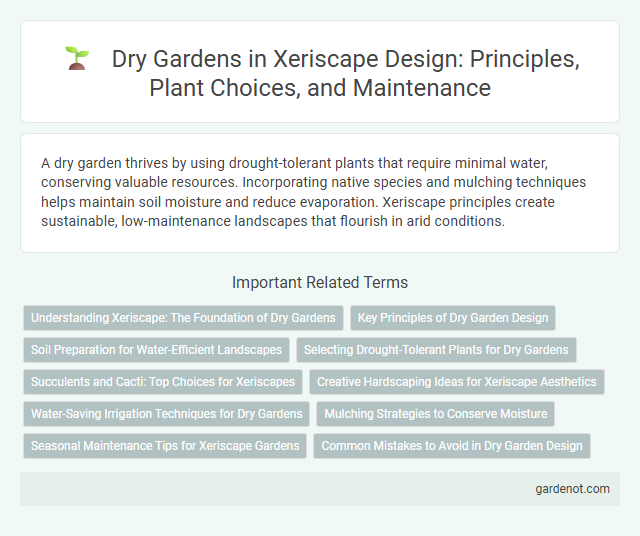A dry garden thrives by using drought-tolerant plants that require minimal water, conserving valuable resources. Incorporating native species and mulching techniques helps maintain soil moisture and reduce evaporation. Xeriscape principles create sustainable, low-maintenance landscapes that flourish in arid conditions.
Understanding Xeriscape: The Foundation of Dry Gardens
Xeriscape is a sustainable landscaping method designed specifically for dry gardens, emphasizing water conservation and drought-tolerant plants. This technique incorporates native and climate-adapted species, efficient irrigation systems, and soil improvement strategies to maintain garden health with minimal water use. Understanding xeriscape principles is essential for creating resilient dry gardens that thrive in arid environments while reducing environmental impact.
Key Principles of Dry Garden Design
Dry garden design prioritizes water efficiency by selecting drought-tolerant plants such as succulents, native grasses, and deep-rooted perennials that thrive in arid conditions. Soil improvement techniques like mulching and organic amendments enhance moisture retention and reduce evaporation. Strategic plant placement and efficient irrigation methods, including drip systems, optimize water use while maintaining aesthetic appeal and biodiversity.
Soil Preparation for Water-Efficient Landscapes
Soil preparation for xeriscape dry gardens involves improving soil structure to enhance water retention and drainage by incorporating organic matter such as compost or mulch. Testing and amending soil pH ensures optimal nutrient availability for drought-tolerant plants. Proper soil aeration techniques reduce compaction, promoting root growth and maximizing water efficiency in arid landscapes.
Selecting Drought-Tolerant Plants for Dry Gardens
Selecting drought-tolerant plants for dry gardens involves choosing species adapted to arid conditions, such as succulents, ornamental grasses, and native shrubs. These plants exhibit deep root systems and thick, water-retentive leaves that minimize water loss. Incorporating cacti, lavender, and agave ensures sustainability and vibrant landscaping with minimal irrigation.
Succulents and Cacti: Top Choices for Xeriscapes
Succulents and cacti are ideal plants for xeriscape gardens due to their exceptional drought tolerance and low water requirements. Species such as Agave, Aloe, Echeveria, and Opuntia thrive in arid conditions while adding unique textures and colors to dry landscapes. Incorporating these resilient plants enhances water conservation efforts and creates visually appealing, sustainable garden designs tailored for dry climates.
Creative Hardscaping Ideas for Xeriscape Aesthetics
Creative hardscaping ideas for xeriscape aesthetics emphasize the use of permeable pavers, decorative gravel, and natural stone pathways to enhance functionality while conserving water. Incorporating features like raised beds with drought-tolerant succulents, sculptural boulders, and strategically placed seating areas provides visual interest and low-maintenance appeal. These elements combine to create sustainable, visually striking dry gardens ideal for arid landscapes.
Water-Saving Irrigation Techniques for Dry Gardens
Water-saving irrigation techniques such as drip irrigation and soaker hoses deliver precise moisture directly to plant roots, minimizing evaporation and runoff in dry gardens. Implementing smart controllers and soil moisture sensors optimizes watering schedules based on plant needs and climatic conditions, ensuring efficient water use. Mulching around plants further reduces soil evaporation, enhancing water retention and promoting healthy xeriscape growth.
Mulching Strategies to Conserve Moisture
Mulching in xeriscape dry gardens plays a crucial role in conserving soil moisture by reducing evaporation and regulating soil temperature. Organic mulches like bark, straw, and compost improve water retention and support healthy plant roots by slowly releasing nutrients. Using a 2-4 inch layer of mulch around drought-tolerant plants enhances water efficiency and minimizes the need for frequent irrigation in arid landscapes.
Seasonal Maintenance Tips for Xeriscape Gardens
Seasonal maintenance for xeriscape gardens involves adapting irrigation schedules to match rainfall patterns and minimizing water usage during dry periods. Pruning drought-tolerant plants and removing dead foliage helps maintain plant health and encourages new growth. Applying mulch in spring and fall conserves soil moisture and reduces weed growth, essential for sustaining a thriving dry garden ecosystem.
Common Mistakes to Avoid in Dry Garden Design
Overwatering remains a common mistake in dry garden design, as it undermines water conservation efforts and stresses drought-tolerant plants. Selecting non-native or water-intensive species can lead to poor plant survival and increased maintenance. Ignoring soil preparation and drainage often causes root rot or poor growth, reducing the overall success of a xeriscape garden.
Dry garden Infographic

 gardenot.com
gardenot.com